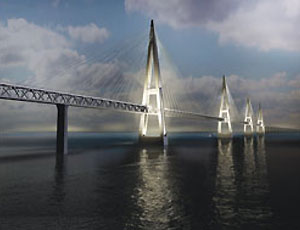Denmark seems to turn out another major fixed road and rail link on a regular basis. Rival design teams have just been chosen to work on bridge and sunken tube options for a 20-km crossing of the Femern Belt to northern Germany, with construction planned to start in just over two years. Two similar mega-projects had already been finished in quick succession.

The Danish government is due now to confirm the appointment of publicly-owned Femern B�lt A/S (FBAS), Copenhagen, as its project developer. Following a treaty with Germany last September, Denmark will finance and build the entire crossing, with Germany handling only its onshore portion.
Denmark’s parliament ratified the treaty late last month and German legislation is in hand. “So far we have made a lot of investigations in terms of financial proposals to get a treaty signed,” says Peter Lundhus, FBAS’s managing director.
Now he’s turning to engineering. On April 6, FBAS signed two design contracts, each worth around $13 million, says Lundhus. The team behind the selected option will go on to vet construction bids and monitor subsequent detailed design and site work.
Lundhus estimates the bridge option cost at $4.7 to $5.3 billion. The tunnel would be around $1.3 billion more. But the final choice “is not a foregone conclusion,” he says. “We have to investigate both to make sure...we have a fallback”.
FBAS settled on a sunken tube option as difficult clay soil near Germany “is not suitable for bored tunnels,” says Lundhus. A joint venture of locally-based RambØll Denmark A/S with Ove Arup & Partners International Ltd., London, and Netherlands-based Tunnel Engineering Consultants, Nijmegen, are handling tunnel studies. “The bridge will be more predictable (with) slightly less risk, probably in construction, and cheaper,” says Arup’s chairman, Philip Dilley. “But with the tunnel, once it’s there, there’s no shipping (or) collision risk”.
Cowi A/S, Copenhagen, leads the bridge study team, including Germany’s Obermeyer Planen + Beraten GmbH., Munich. The design is now “wide open”, says Lars Hauge, Cowie’s bridge director.
“It’s clear there will have to be a substantial main span, either cable stayed or suspended,” adds Hauge. One option is to replicate the 1,624-m-long suspended East Bridge built across Denmark's Great belt in the early 1990s.
“The new thing here is that (the bridge) has to carry railway traffic,” says Hauge. Deflections, passenger comfort and escape routes will be among key design factors.
Stretching for 17-km of the 20-km crossing, the approaches will “start our main focus,” says Hauge. Approaches will likely account for “60% of the cost or more,” he adds. A key design consideration will be ensuring that structures will not interfere with water flows to alter the delicate salt balance in the Baltic Sea, he says.
At around 30-m, water depth is about three times deeper on Femer link than at the Denmark-Sweden Øresund crossing inaugurated in 2000. The new project is “50% bigger on all sides,” says Lundhus, who held senior posts on the Øresund and earlier Great Belt projects.
With about half FBAS’s team of some 35 people being veterans of Øresund, their experience “is extremely valuable,” says Lundhus. “We know what to do and what order to do it in”. But on the Femer job, “we have to take care of things also in Germany,” he adds. That includes managing a “difficult legal process”.
FBAS may emulate the procurement approach used at Øresund, where the owner supplied fairly detailed illustrative designs to the design/build contractor. At Øresund, “we got about 90% of our illustrative design (built),” says Lundhus.
As with Øresund, FBAS will finance construction with debt, funded by tolls on the crossing. Despite current difficult financial conditions “with state guarantees, we will have little difficulty borrowing money,” say Lundhus. And the project stands to benefit from tight bidding.


Post a comment to this article
Report Abusive Comment